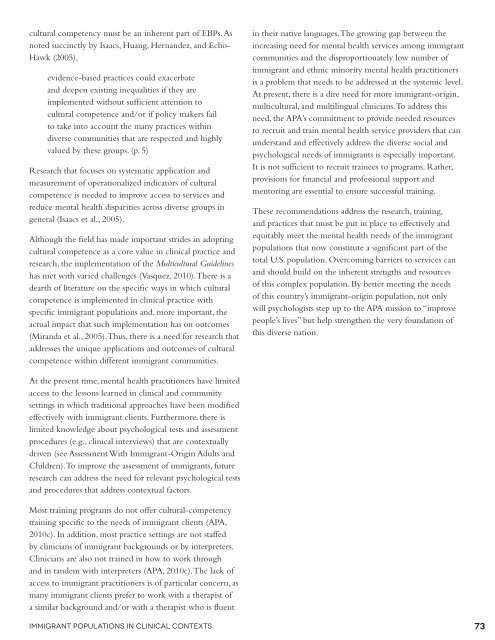Crossroads: The Psychology of Immigration in the New Century
Crossroads: The Psychology of Immigration in the New Century
Crossroads: The Psychology of Immigration in the New Century
You also want an ePaper? Increase the reach of your titles
YUMPU automatically turns print PDFs into web optimized ePapers that Google loves.
cultural competency must be an <strong>in</strong>herent part <strong>of</strong> EBPs. As<br />
noted succ<strong>in</strong>ctly by Isaacs, Huang, Hernandez, and Echo-<br />
Hawk (2005),<br />
evidence-based practices could exacerbate<br />
and deepen exist<strong>in</strong>g <strong>in</strong>equalities if <strong>the</strong>y are<br />
implemented without sufficient attention to<br />
cultural competence and/or if policy makers fail<br />
to take <strong>in</strong>to account <strong>the</strong> many practices with<strong>in</strong><br />
diverse communities that are respected and highly<br />
valued by <strong>the</strong>se groups. (p. 5)<br />
Research that focuses on systematic application and<br />
measurement <strong>of</strong> operationalized <strong>in</strong>dicators <strong>of</strong> cultural<br />
competence is needed to improve access to services and<br />
reduce mental health disparities across diverse groups <strong>in</strong><br />
general (Isaacs et al., 2005).<br />
Although <strong>the</strong> field has made important strides <strong>in</strong> adopt<strong>in</strong>g<br />
cultural competence as a core value <strong>in</strong> cl<strong>in</strong>ical practice and<br />
research, <strong>the</strong> implementation <strong>of</strong> <strong>the</strong> Multicultural Guidel<strong>in</strong>es<br />
has met with varied challenges (Vasquez, 2010). <strong>The</strong>re is a<br />
dearth <strong>of</strong> literature on <strong>the</strong> specific ways <strong>in</strong> which cultural<br />
competence is implemented <strong>in</strong> cl<strong>in</strong>ical practice with<br />
specific immigrant populations and, more important, <strong>the</strong><br />
actual impact that such implementation has on outcomes<br />
(Miranda et al., 2005). Thus, <strong>the</strong>re is a need for research that<br />
addresses <strong>the</strong> unique applications and outcomes <strong>of</strong> cultural<br />
competence with<strong>in</strong> different immigrant communities.<br />
At <strong>the</strong> present time, mental health practitioners have limited<br />
access to <strong>the</strong> lessons learned <strong>in</strong> cl<strong>in</strong>ical and community<br />
sett<strong>in</strong>gs <strong>in</strong> which traditional approaches have been modified<br />
effectively with immigrant clients. Fur<strong>the</strong>rmore, <strong>the</strong>re is<br />
limited knowledge about psychological tests and assessment<br />
procedures (e.g., cl<strong>in</strong>ical <strong>in</strong>terviews) that are contextually<br />
driven (see Assessment With Immigrant-Orig<strong>in</strong> Adults and<br />
Children). To improve <strong>the</strong> assessment <strong>of</strong> immigrants, future<br />
research can address <strong>the</strong> need for relevant psychological tests<br />
and procedures that address contextual factors.<br />
Most tra<strong>in</strong><strong>in</strong>g programs do not <strong>of</strong>fer cultural-competency<br />
tra<strong>in</strong><strong>in</strong>g specific to <strong>the</strong> needs <strong>of</strong> immigrant clients (APA,<br />
2010c). In addition, most practice sett<strong>in</strong>gs are not staffed<br />
by cl<strong>in</strong>icians <strong>of</strong> immigrant backgrounds or by <strong>in</strong>terpreters.<br />
Cl<strong>in</strong>icians are also not tra<strong>in</strong>ed <strong>in</strong> how to work through<br />
and <strong>in</strong> tandem with <strong>in</strong>terpreters (APA, 2010c). <strong>The</strong> lack <strong>of</strong><br />
access to immigrant practitioners is <strong>of</strong> particular concern, as<br />
many immigrant clients prefer to work with a <strong>the</strong>rapist <strong>of</strong><br />
a similar background and/or with a <strong>the</strong>rapist who is fluent<br />
Immigrant Populations <strong>in</strong> Cl<strong>in</strong>ical Contexts<br />
<strong>in</strong> <strong>the</strong>ir native languages. <strong>The</strong> grow<strong>in</strong>g gap between <strong>the</strong><br />
<strong>in</strong>creas<strong>in</strong>g need for mental health services among immigrant<br />
communities and <strong>the</strong> disproportionately low number <strong>of</strong><br />
immigrant and ethnic m<strong>in</strong>ority mental health practitioners<br />
is a problem that needs to be addressed at <strong>the</strong> systemic level.<br />
At present, <strong>the</strong>re is a dire need for more immigrant-orig<strong>in</strong>,<br />
multicultural, and multil<strong>in</strong>gual cl<strong>in</strong>icians. To address this<br />
need, <strong>the</strong> APA’s commitment to provide needed resources<br />
to recruit and tra<strong>in</strong> mental health service providers that can<br />
understand and effectively address <strong>the</strong> diverse social and<br />
psychological needs <strong>of</strong> immigrants is especially important.<br />
It is not sufficient to recruit tra<strong>in</strong>ees to programs. Ra<strong>the</strong>r,<br />
provisions for f<strong>in</strong>ancial and pr<strong>of</strong>essional support and<br />
mentor<strong>in</strong>g are essential to ensure successful tra<strong>in</strong><strong>in</strong>g.<br />
<strong>The</strong>se recommendations address <strong>the</strong> research, tra<strong>in</strong><strong>in</strong>g,<br />
and practices that must be put <strong>in</strong> place to effectively and<br />
equitably meet <strong>the</strong> mental health needs <strong>of</strong> <strong>the</strong> immigrant<br />
populations that now constitute a significant part <strong>of</strong> <strong>the</strong><br />
total U.S. population. Overcom<strong>in</strong>g barriers to services can<br />
and should build on <strong>the</strong> <strong>in</strong>herent strengths and resources<br />
<strong>of</strong> this complex population. By better meet<strong>in</strong>g <strong>the</strong> needs<br />
<strong>of</strong> this country’s immigrant-orig<strong>in</strong> population, not only<br />
will psychologists step up to <strong>the</strong> APA mission to “improve<br />
people’s lives” but help streng<strong>the</strong>n <strong>the</strong> very foundation <strong>of</strong><br />
this diverse nation.<br />
73
















